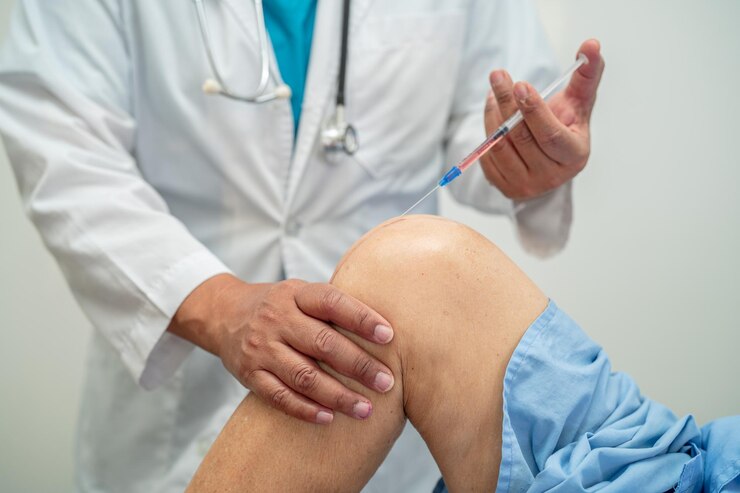The most common condition demonstrating the best response to shockwave therapy is plantar fasciopathy. The condition is also referred to as policeman’s foot. The pain is generally experienced on the calcaneus (medial tubercle) of the heel. Pain can also be present from the base of the toes to the soft tissue of the foot. The area represents the inside of the calcaneal or the bone struck by the heel when coming in contact with the ground. Due to the bio-mechanical structure of the foot, the most common pattern for footfalls is a heel strike.
Just the heel strike may not be the cause of the issue. The condition can be contributed to by factors involving both the joints and hip above the ankle. Many of the patients with plantar fasciitis have diabetes, a high BMI or other pathologies impacting the foot. Many of these individuals think about their foot last. Unfortunately, a severe case of plantar fasciopathy can result in pain and significant discomfort for those affected. The condition often limits mobility leading to other health conditions becoming worse.
A large portion of the population have been impacted due to this condition. Approximately two million individuals in America visit a physician every year for treatment of this type of condition. The College of Podiatry has stated 75 to 80 percent of all individuals in the United Kingdom have reported some type of foot issue resulting in a loss of over 44 million workdays per year. The most common symptoms of plantar fasciopathy are pain after resting or during the morning. Once the area has a chance to warm up, there is usually some movement improvement.
When the condition is severe, the individual often experiences issues with walking. Due to the number of individuals treated on a yearly basis, a lot of patients have already tried physiotherapy, heel supports, injections and acupuncture. The biomechanical issue can be improved by lifting the arches and heel with orthotic devises. The patient is usually left with consistent pain in the foot. Imaging is used for a clinical assessment to confirm or exclude the diagnosis. Some of the indicators of plantar fasciopathy can be confirmed without the necessity of screening.
One of the best tests is to hold the toes as they are brought towards the body. As the tendon is stretched, any pain on the bottom of the foot may be an indication of plantar fasciopathy. If the case is chronic, there may be visible swelling on the heel pad. In 2008, Gerdesmeyer conducted the largest shockwave therapy, double-blind study to determine the effectiveness of the procedure. The study revealed conclusive proof shockwave therapy is an effective and safe treatment for recalcitrant fasciopathy. The definition of recalcitrant is being stubborn to heal or nonresponsive.
The study resulted in guidelines established by NICE in 2009. The reason the foot is often difficult to treat is the complex biomechanical nature. Shockwave therapy is one of the most successful treatments for this condition.
Using Shockwave Therapy for the Treatment of Plantar Fasciitis
The medical term is extracorporeal shockwave therapy for the treatment of refractory plantar fasciitis. The definition of refractory is being unresponsive to conventional treatments, with extracorporeal defined as outside of the body. A shock wave is a high-energy, inaudible sound wave. A specialist will describe shockwave therapy in detail for their patients. When the ligament located beneath the foot between the toes and heel deteriorates, the result is plantar fasciitis and foot pain. The condition often occurs after an injury.
The conventional treatments include anti-inflammatory and pain medications, rest, support devices, the application of ice, corticosteroid injection, physical exercises and physiotherapy. This procedure involves the passing of shock waves through the skin to the area affected using a special device. Ultrasound guidance is sometimes used as well. Shockwave therapy may require one or multiple sessions or involve local anaesthesia when high-energy shockwaves are necessary due to the pain of this procedure. The outcome of the procedure can be affected by local anaesthesia.
According to NICE
There is evidence showing shockwave therapy is safe. Despite this, uncertainties remain regarding the way the procedure works. When a physician recommends shockwave therapy to one of their patients, they should take the time necessary to explain the uncertainty regarding the effectiveness of the procedure and all of the potential risks. The discussion should take place prior to the patient deciding whether or not they want to have the procedure. The physician should give the patient written information and the NICE leaflet during the discussion.
Special arrangements should also be made for monitoring the individual after the treatment. Additional research has been encouraged by NICE regarding the effectiveness of shockwave therapy for individuals with plantar fasciitis. The progress of the individual should be monitored for at least 12 months after completion of the treatment. When additional evidence is available, the procedure may be reviewed by NICE. The committee experienced difficulty interpreting the data due to the extreme differences in the studies.
The results were not consistent, although the effect of placebo treatments was extremely beneficial. If the procedure proves effective for certain patients, the impact on plantar fasciitis may be significant. Not only is the condition common, but traditional treatments are ineffective for many of the patients. The need for reliable evidence is exceptionally important. When a physician recommends shockwave therapy to a patient, the fact NICE states the procedure is safe should be mentioned. The physician should also tell the patient uncertainties exist regarding effectiveness.
The above statements do not indicate the patient should not have the procedure. The patient simply needs to understand everything involved with the treatment in addition to the potential risks and benefits. No patient should agree to have shockwave therapy until they have had a discussion with the physician, been provided with the NICE leaflet and written information. NICE has determined additional information regarding the procedure is necessary. For this reason, the patient may be asked if their treatment can be used to provide more information about shockwave therapy.
The Published Studies
According to reports from published studies, in excess of two million individuals receive treatment for plantar fasciitis every year. This is roughly 11 to 15 percent of all visits with physicians for foot-related issues. The inflammation from plantar fasciitis is painful. If the individual does not receive treatment, the condition can result in degenerative changes to the fascia. The success rates shown for the more traditional options such as conservative medication and measures are between 44 and 82 percent.
Releasing the plantar fascia through surgical intervention involving an endoscopic or open release offers a slow recovery of up to a year, substantial risks and unpredictable results. A lot of clinical evidence for shockwave therapy has been built by researchers. Several randomised studies have shown shockwave therapy is both effective and safe including the Gerdesmeyer study. When nonsurgical treatment is not successful, shockwave therapy offers a good option for surgery and focused shockwave therapy because no anesthesia is necessary.
The Effectiveness of Shockwave Therapy
One study involved 293 participants. The procedure was performed on 144 individuals, with a dummy placebo being used for the remainder of the patients. The pain decreased after three months for 67 patients without the need for pain medication. Another study involved 172 participants. At the end of three months, the decrease in pain was greater for the 112 participants receiving the treatment than the 56 participants receiving the placebo procedure.
A third study was conducted with 149 participants. Of the participants receiving the procedure, 69 percent stated their result was excellent with all heel pain eliminated. All of the participants receiving a conventional treatment still had some pain after 64 months. In addition to reviewing all of these studies, NICE spoke to experts regarding their views. The advisors contacted are clinical specialists for this specific type of medicine, The advisers stated the main benefits of shockwave therapy is relief from the symptoms of plantar fasciopathy.
The Risks and Potential Issues
Two studies encompassed a total of 221 participants receiving a placebo treatment and 216 receiving shockwave therapy. Of the participants receiving the procedure, eight experienced pain in comparison to the three among the placebo group. Another procedure showed only six of 61 participants receiving the procedure experienced skin reddening and throbbing pain. Of the 64 participants receiving a corticosteroid injection, eight experienced pain so severe they required either ice or medication for approximately one week.
Another study involving 135 participants resulted in 16 patients receiving the procedure experiencing skin reddening in comparison to the five of 136 participants receiving the placebo procedure. Another two studies encompassed 250 participants receiving the procedure. Four experienced swelling in the treatment area. In addition to reviewing these studies, NICE consulted with clinical specialists in this medical field. The advisers stated the issues included skin damage, pain and bruising around the treatment site.
The theory is these specific issues may result in a worsening of the condition due to damage to the soft tissue or rupturing the ligament located underneath the foot.
About NICE
NICE offers guidance to the NHS regarding the prevention, diagnosis and treatment of a wide variety of medical conditions. Written advice is provided by independent experts such as individuals representing carers and patients and healthcare professionals. NICE takes into consideration both the safety and effectiveness of the procedures in addition to asking expert advisers for their opinions. Guidance for interventional procedures is provided to the entire NHS throughout Wales, Northern Ireland, England and Scotland. Staff working for the NHS are expected to adhere to this advice.
Related Articles
- Treatment of Plantar Fasciitis using Shockwave Therapy
- Shockwave Therapy For Running Injuries
- Shockwave Therapy FAQs
- Shockwave Therapy – Radial and Focus
- Can Shockwave Therapy Help With Musculoskeletal Problems
- Types of Tendonitis that Shockwave Therapy Can Treat



